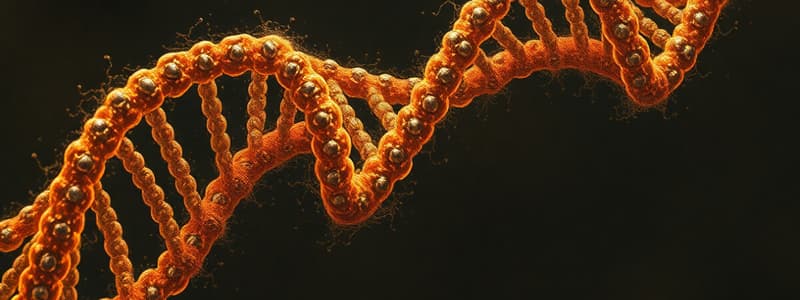Podcast
Questions and Answers
What is the primary function of helicase in DNA replication as depicted in the animation?
What is the primary function of helicase in DNA replication as depicted in the animation?
- To unwind the DNA double helix into two strands. (correct)
- To proofread the newly synthesized DNA molecules.
- To synthesize new DNA strands continuously.
- To rewind the DNA double helix after replication.
Why is one strand of DNA copied continuously while the other is copied in sections?
Why is one strand of DNA copied continuously while the other is copied in sections?
- Because one strand is more prone to damage.
- Because helicase can only move in one direction.
- To introduce errors and increase genetic diversity.
- Due to the antiparallel nature of DNA strands. (correct)
In the animation, what structural change does DNA undergo as it enters the replication process?
In the animation, what structural change does DNA undergo as it enters the replication process?
- It transforms into a single-stranded RNA molecule.
- It forms a knot-like structure to initiate replication.
- It unwinds from a double helix into two separate strands. (correct)
- It coils more tightly to protect itself.
What is the end product of the DNA replication process shown in the animation?
What is the end product of the DNA replication process shown in the animation?
How does the animation describe the speed of helicase in unwinding DNA?
How does the animation describe the speed of helicase in unwinding DNA?
What is the significance of copying one DNA strand in loops, as depicted in the animation?
What is the significance of copying one DNA strand in loops, as depicted in the animation?
Which of the following best describes the 'biochemical machines' involved in DNA replication?
Which of the following best describes the 'biochemical machines' involved in DNA replication?
What distinguishes the copying process of one DNA strand from the other during replication?
What distinguishes the copying process of one DNA strand from the other during replication?
How does the animation visually explain the complex process of DNA replication?
How does the animation visually explain the complex process of DNA replication?
Why is it important to understand the mechanics of DNA replication, as shown in the animation?
Why is it important to understand the mechanics of DNA replication, as shown in the animation?
Which enzyme is responsible for unwinding the DNA double helix at the start of replication?
Which enzyme is responsible for unwinding the DNA double helix at the start of replication?
The animation showcases a process where DNA is copied. What is the biological significance of this process?
The animation showcases a process where DNA is copied. What is the biological significance of this process?
What technique allows us to visualize DNA replication in living cells, as described?
What technique allows us to visualize DNA replication in living cells, as described?
How does the copying mechanism handle the strand that must be copied backwards?
How does the copying mechanism handle the strand that must be copied backwards?
During DNA replication, how many new DNA molecules are produced from one original DNA molecule?
During DNA replication, how many new DNA molecules are produced from one original DNA molecule?
Which of the following enzymes is directly involved in synthesizing the new DNA strands?
Which of the following enzymes is directly involved in synthesizing the new DNA strands?
In what direction does DNA polymerase synthesize new DNA?
In what direction does DNA polymerase synthesize new DNA?
What is the role of single-strand binding proteins (not explicitly mentioned, but relevant to the process) during DNA replication?
What is the role of single-strand binding proteins (not explicitly mentioned, but relevant to the process) during DNA replication?
What are Okazaki fragments?
What are Okazaki fragments?
What is the role of DNA ligase in DNA replication?
What is the role of DNA ligase in DNA replication?
Flashcards
Helicase
Helicase
An enzyme that unwinds the DNA double helix at the replication fork, separating the two strands to allow for DNA replication.
DNA Replication
DNA Replication
The process where a DNA molecule is duplicated, resulting in two identical copies of the original DNA molecule.
DNA Double Helix
DNA Double Helix
The structure of DNA where two strands are wound around each other, resembling a twisted ladder.
Study Notes
- Computer animation based on molecular research allows visualization of DNA replication in living cells
- The process involves an assembly line of miniature biochemical machines
- These machines separate the DNA double helix
- They create a copy of each strand
- DNA to be copied enters the production line from the bottom left.
Helicase
- Helicase is a whirling blue molecular machine.
- It unwinds the double helix DNA into two strands.
- It spins the DNA as fast as a jet engine.
DNA Copying
- One strand is copied continuously and spools off to the right.
- The other strand must be copied backward in sections.
- It is drawn out repeatedly in loops.
- The end result is two new DNA molecules.
Studying That Suits You
Use AI to generate personalized quizzes and flashcards to suit your learning preferences.




